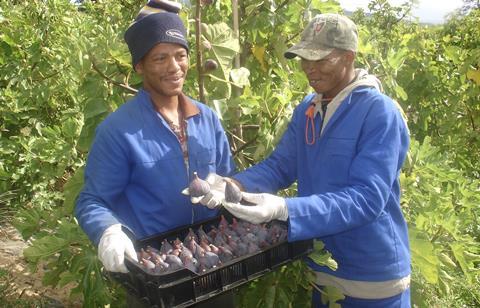The country’s fig industry is confident that it will exceed the previous season’s export volumes
Following one of its best production seasons in 2021/22, during which nearly 250,000 cartons were exported, South Africa’s fig exports dropped to below 100,000 cartons in 2022/23.

This is reflected in the latest edition of Fresh Food Trade South Africa, published by the fresh produce export industry, which records all of the country’s fruit and vegetable exports.
Compared with South Africa’s overall fresh produce exports, which run just short of 300m cartons, the fig export industry is very much a fledgling industry.
However, specialised export teams have been slowly working to achieve long term growth.
Sources in the industry have said that one of the main problems is the low level of production, which is too small to justify a fig industry body that would bring about greater coordination.
“It is difficult to get immediate short-term information which allows for export planning,” exporters stated.
Two export companies, Stems based in Paarl and Star South from Wellington, are reported to be the biggest exporters.
“Although just past mid-season the crop tends to look more promising in comparison with last year the same time,” said Annelie Haumann, CEO of Stems. “Considering the sensitivity of the commodity the later part of our season will be dictated by the weather conditions.
“With committed growers we are positive about the future of fresh figs within South Africa,” she outlined. ’Minor fruit categories have shown that our growers have the resilience and expertise to deal with sensitive products and deliver them into the most demanding consumer markets.”
South Africa’s flagship fig variety is Parisian, also called Evita. It is the most widely planted variety in the country. The small-to-medium fruit has purple skin and red flesh, and is said to have excellent eating quality and good shelf-life.
In an attempt to extend the production window, improve eating quality and increase shelf-life, exporters are focused on bringing in new, promising varieties to commercialise in the near future.
Before new plantings of commercial varieties for the fresh market in 2003, South Africa’s fig industry was based on production for drying and preservatives.
Production declined from around 400,000 trees in the 1940s to less than 30ha in the early 2000s.
Since then, increased migration from southern European countries to nations in the north such as the UK and Germany, brought about a new demand for exotic fruits that until recently did not translate strongly to retail shelves.
Figs are one such fruit and this is potentially creating new opportunities for South African growers.
It was reported that 222ha had been planted for commercial fig production by 2019, but since then several orchards have been removed as it was not financially viable for those growers.
Production is mainly concentrated in the Western Cape, where growers experience warm, dry summers.
Regions well known for growing fresh figs include the Swartland, Paarl, Worcester, Prince Albert, Napier in the Overberg and the Kammanassie area near Oudtshoorn.



